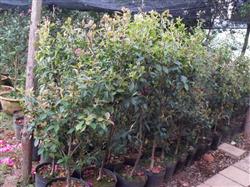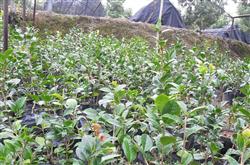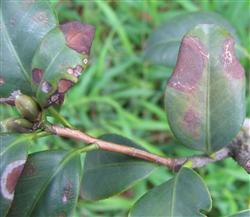How do camellias propagate and grow?

How do camellias reproduce and grow? Please introduce the methods of Camellia propagation and planting can refer to the following methods: Propagation techniques 1, cuttage in the rainy season in May to June, select young mother trees, cut from the top of the annual shoots, about 10cm long, remove the lower leaves, in the lower part of the node with a blade cut flat, the top to retain a terminal bud lateral bud each, leaves 2 to 3, inserted in the river sand or gravel medium, insertion depth 1/3 to 2 ~ 3. Cover with straw curtain after transplanting, strengthen foliar spray, keep air humidity of transplanting bed, promote rooting. In order to improve the survival rate of cuttings, 50~100ppm ABT rooting powder solution can be used to soak cuttings for 8~12 hours. 2. Grafting Choose healthy seedlings or camellia varieties that are easy to survive from cuttings as rootstocks, cut them off at 4~5cm from the ground diameter, split them about 1.5cm deep through the pith, use 1~2-year-old branches as scions, keep 1~2 leaves on the upper part of the scion, cut the lower part into wedges, insert them into the cracks split by the rootstocks, and the cambium of both sides should be closely combined, and then tie them tightly with plastic belts. After grafting, put a plastic bag on the scion mask and tie it with tape below, but not too tight, so that water drops form in the bag and keep dripping on the rootstock. Then add a paper bag outside the plastic bag to shield it from direct sunlight. 3. Bud insertion takes each bud node as a section, retains a leaf, about 1.5cm long, cuts the lower part obliquely, and then inserts it into the medium, and the depth is to cover the branches. This method can make full use of branches, suitable for mass reproduction needs. 1. Open field planting 1)The soil is selected from fertile slightly acidic soil with good drainage, and the PH value is between 5.5 and 6. 2)The planting time is from February to March. The seedlings are mainly planted in spring, and the effect is better when planted in autumn after November. 3)Fertilization camellia does not like fertilizer, generally 10~11 months before flowering, 4~5 months after flowering, fertilization 2~4 times. Fertilizers mainly use compound fertilizer, compost, and combined with appropriate phosphorus fertilizer;(fertilization principle thin fertilizer more fertilizer. The young seedlings are more applied, the weak seedlings are less applied or not applied). 4)Camellia growth slow, not intensity pruning; crown development evenly, also do not need special pruning, just cut off pests branches, over-dense branches, weak branches and excessive long branches. New seedlings, in order to ensure survival, can also be appropriately pruned. Bud picking is an important part of cultivation and management. Generally, each branch can retain at most 3 buds and maintain a certain spacing, which can reduce the excessive consumption of plant nutrients and affect flowering. Camellia flowering up to half a year, timely get rid of the withered flowers, reduce nutrient consumption, enhance tree vigor has great benefits. 5)The main diseases of camellia are brown spot, chlorosis and moss parasitism. The pest is red spider. All kinds of scale insects, thorn moths. Rose sawfly, etc. The occurrence of diseases and insect pests greatly affects the tree vigor and its ornamental nature. The control methods were as follows: spraying bordeaux mixture before brown spot germination in spring, spraying prevention every half month, paying attention to drainage and fertilization, removing damaged leaves and burning them. Chlorosis is mainly caused by lack of trace elements in soil, and can be controlled by applying ferrous sulfate or magnesium sulfate solution to wine frequently. Red spider and all kinds of scale insects control spray turpentine mixture and strengthen ventilation. All kinds of thorn moths. The rose sawfly was sprayed with 40% omethoate 400~155 times or 80% dichlorvos EC 1000~1200 times. Intertill weeding and cleaning the garden can also effectively control pests, strengthen tree vigor and make flowers plump. 6 - 7 times of cultivation are required throughout the year. 2, potted plants 1) pot soil selection selection of slightly acidic, loose, fertile mixed soil for pot soil. The proportion of mixed soil is garden soil 6 parts, loose leaf humus soil 3 parts and sandy soil 1 ~2 parts. 2) The best pot selection and cultivation is clay pot, the ratio of pot size to seedling is: seedling height 40~50cm, crown width 20~25cm, pot diameter about 20cm. Other sizes and so on. Purple sand pot is better for commercial seedlings, which can improve the viewing effect. 3) Potted seedling selection Select plants with strong growth, trunk, single stem without branches, beautiful crown, tender green leaves and no pests. 4)Watering management of new seedlings, the first irrigation of sufficient water, 2 months of frequent watering, keep the pot soil moist. Later, water the seedlings in the same way as other flowers and trees. The frequency depends on climatic conditions to keep the soil moist. More watering in spring to meet the needs of germination and shoot; summer should be in the morning and evening, rainy season to prevent water, autumn drought to timely watering, winter for antifreeze, watering at noon. 5)Camellias should be given sufficient sunshine in spring and rainy season, shade and cool down in summer and autumn; when the temperature drops to zero in winter, it is necessary to move indoors for cold protection. 6)Flowering time control is mainly through variety selection, temperature control and hormone treatment to achieve the goal of early flowering or late flowering. For example, in order to delay flowering, late flowering varieties can be selected and controlled at low temperature (cold storage above 2~3 degrees, storage of plants treated with cold wrapping), and flowering can be delayed by one month. In order to make it blossom early, we should choose early flowering varieties such as small peach and snow tower, and then apply heavy fertilizer and hormone treatment. The method is to stop the growth of camellia in spring. After flower bud formation, apply heavy fertilizer to make the young shoots after flowering mature early and stop growing early; apply 500~1000PPm gibberellin to the flower buds with a writing brush in mid July or early August, once every three days, accompanied by reasonable water and fertilizer; apply gibberellin again according to the hypertrophy of flower buds in September. If fertilizer is applied, the flower buds will grow rapidly and bloom early from late September to November. Click to get more Camellia planting technology Click to get more Flower planting technology
- Prev

What are the propagation methods of camellias?
What are the propagation methods of camellias? Please give a detailed introduction to many propagation methods of camellias, both sexual and asexual reproduction can be used, of which cutting and grafting are the most common, the following propagation methods are for reference: 1. The cutting method is the most simple and convenient, the best cutting time is September, and it can also be in spring. Choose to grow well.
- Next

What diseases do camellias have to control?
What diseases do camellias have to control? How should prevention be carried out? Please give an introduction to the diseases that need to be controlled by Camellia: Anthracnose [Etiology and Symptoms] The disease is caused by the infection of Camellia leaves by Fusarium oxysporum. This is the main disease of camellia, with an incidence of 33%. The disease occurs mostly at leaf margins, leaf tips and both sides of veins....
Related
- Fuxing push coffee new agricultural production and marketing class: lack of small-scale processing plants
- Jujube rice field leisure farm deep ploughing Yilan for five years to create a space for organic food and play
- Nongyu Farm-A trial of organic papaya for brave women with advanced technology
- Four points for attention in the prevention and control of diseases and insect pests of edible fungi
- How to add nutrient solution to Edible Fungi
- Is there any good way to control edible fungus mites?
- Open Inoculation Technology of Edible Fungi
- Is there any clever way to use fertilizer for edible fungus in winter?
- What agents are used to kill the pathogens of edible fungi in the mushroom shed?
- Rapid drying of Edible Fungi

